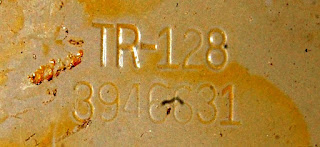This clearly dates to the 1960s. The fact that someone painted the front panel exaggerates the ugly institutional aesthetics. Here's the intact lettering of a gutted one:
Still isn't winning any design of the year awards, though to be honest I enjoy the ugly angular stuff from the institutional schools of thought about as much as I enjoy the sculpted and primitive platforms from previous decades. Since this stuff is all by and large older than I am, I'll tip my hat to a little respect.
12AX7 weighing in at lower right, one half supports phase inversion for the push-pull output, the other half supports the "MIKE" input. The 6AU6 in the logical position of phase inverter is the line level input/second gain stage for microphone. Can't overlook the pair of 6V6 on output.
It would appear there have been sticky fingers where rectifier tubes are concerned. The red cover at upper right covers an octal plug for input configuration, pictured is the optional Newcomb input transformer. The installed Newcomb part number SF-30 could be confused (perhaps "substituted" is more applicable) with a bit of bent solid copper wiring, ala Romex.
Nothing incredibly odd here. The mains wiring does not appear to strictly adhere to the schematic (following), and the Foster output iron is hanging tough gut-side.
Another octal output connector (the Stromberg Carlson is, of course, wired differently).
I will always be delighted when I open an amp and have access to the schematic. Manufacturers take note!
In boosting the contrast on this image, I noticed a bunch of darker squiggly lines. Which, as it turned out, were present on all recent shots. See, a week ago I noticed a dark spot that was also spanning all images in the same location - indicative of a speck of dust on the face of the sensor. I tried to blow it out, which delivered a spot of spittle. At this point I had to go into fog & clean, and the soft cloth I selected managed to deposit small fibers everywhere. So, the camera is going to get a proper clean once I find my bulb brush, in the meantime I'll live with the artifacts.
Back to the amp, it would appear as if this has been modified as the plate on one half of the 12AX7 is hanging in open space.
CTS potentiometer dated 28th week of 1966.
Foster power transformer dated 31st week of 1966. The electrolytic can cap is dated 3rd week of 1967, that should probably be updated.









No comments:
Post a Comment